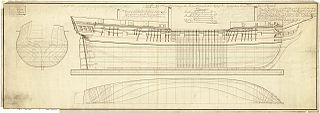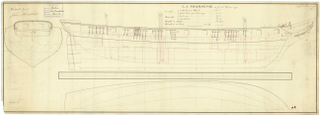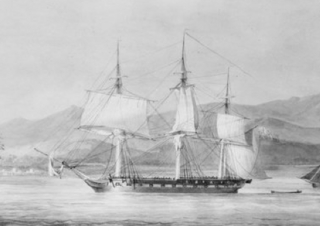
HMS Persian was a Cruizer-class brig-sloop built by Daniel List and launched at Cowes in 1809. She captured two privateers before she wrecked in 1813.
His Majesty's hired armed lugger Black Joke was a lugger of ten 12-pounder carronades and 10892⁄94 tons burthen that entered into the service of the Royal Navy on 22 May 1808.
During the period of the French Revolutionary and Napoleonic Wars, there were two or three vessels known as His Majesty's hired armed cutter Active that served the British Royal Navy. The reason for the uncertainty in the number is that the size of the vessels raises the possibility that the first and second may have been the same vessel.

HMS Clyde was a Royal Navy Artois-class frigate built at Chatham Dockyard of fir, and launched in 1796. In 1797, she was one of only two ships whose captains were able to maintain some control over their vessels during the Nore mutiny. In 1805, HMS Clyde was dismantled and rebuilt at Woolwich Dockyard; she was relaunched on 23 February 1806. She was ultimately sold in August 1814.

HMS Orestes was a 16-gun brig-sloop of the Seagull class of the British Royal Navy, launched in October 1805. She served during the Napoleonic Wars, primarily in the North Sea and the Channel, where she captured three privateers. The Navy sold her in 1817.
Two vessels named His Majesty's hired armed lugger Sandwich served the British Royal Navy, one during the French Revolutionary Wars, and the other during the Napoleonic Wars.

HMS Jalouse was a Cormorant-class ship-sloop of the British Royal Navy launched in 1809 and sold in 1819. She participated in the capture of a French privateer, but spent most of her active service escorting convoys. The Navy sold her in 1819.

HMS Derwent was launched in 1807 and later that year became one of the first ships sent by the British Royal Navy to suppress the slave trade.
Numerous vessels have been named Vautour :

HMS Snake was a British Royal Navy ship launched in 1797 as the only member of her class of brig-sloops. She captured or destroyed two French privateers and one Danish privateer. She also captured numerous small merchantmen, but spent time escorting convoys to and from the West Indies. She was sold in 1816.
HMS Earnest was launched at Leith in 1805 as one of 48 later Archer-class gun brigs for the British Royal Navy. During her naval career Earnest captured five small privateers and numerous merchant vessels. In 1816 the Admiralty sold her and she became the merchantman Earnest. She continued to sail and was last listed in 1850.
HMS Decoy was launched in 1810. She participated in the capture of several small French privateers, captured or recaptured a number of merchant vessels, and captured a number of smuggling vessels. The French captured her in 1814.

HMS Royalist was launched in 1807. She captured many privateers and letters of marque, most French, but also some from Denmark and the United States. Her crew twice were awarded the Naval General Service Medal. She was instrumental in the capture of a French frigate. The Royal Navy sold her in 1819. She then became a whaler, making three complete voyages. She was condemned after a mishap while on her fourth.
Several French privateers have borne the name Rôdeur, French for "lurker":

HMS Trompeuse was the French privateer brig Coureur that the British Royal Navy captured in 1800. She was sold for breaking up in 1811.

HMS Minerva was a 32-gun fifth-rate Thames-class frigate of the Royal Navy, launched in 1805 at Deptford. Her namesake was the Roman goddess Minerva.
HMS Cracker was a later Archer-class gun brig, launched in 1804. She participated in several actions and captured two small French privateers. She was sold for breaking up in 1816.
HMS Dwarf was a Decoy-class cutter launched in 1810. She participated in the capture of a French privateer and in operations in the Gironde. After the end of the Napoleonic Wars she captured some smuggling vessels. She was wrecked in March 1824.
HMS Pioneer was a Pigmy–class schooner of the Royal Navy, launched in 1810 as a cutter. During her service with the Navy she captured one French privateer and assisted at the capture of another. In 1823–1824 she underwent fitting for the Coast Guard blockade. She then served with the Coast Guard to 1845. She was sold at Plymouth in 1849.
HMS Zephyr was a 14-gun Crocus-class brig of the Royal Navy built by Nicholas Diddams at Portsmouth Dockyard and launched there in 1809. During her service she captured two armed vessels. The Navy sold her in 1818 for breaking up.







